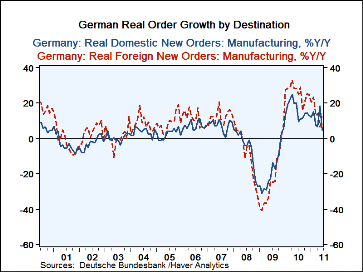 Global| Aug 04 2011
Global| Aug 04 2011German Orders Snap Back
Summary
German orders picked up in June. After falling sharply in May foreign orders surged in June by enough to make up for the May drop. Domestic orders remain in a funk, rising by just 4.6% over 12-months compared to a rise of 13.2% for [...]
 German orders picked up in June. After falling sharply in May foreign orders surged in June by enough to make up for the May drop.
Domestic orders remain in a funk, rising by just 4.6% over 12-months compared to a rise of 13.2% for foreign orders.
Sequentially domestic orders remain weak while foreign orders are on the rise after a period of unevenness.
German orders picked up in June. After falling sharply in May foreign orders surged in June by enough to make up for the May drop.
Domestic orders remain in a funk, rising by just 4.6% over 12-months compared to a rise of 13.2% for foreign orders.
Sequentially domestic orders remain weak while foreign orders are on the rise after a period of unevenness.
Manufacturing sales are slipping in the Zone. The three month annualized rate of growth for sales is just 1.1%. Consumer durables sales are off at a 14.5% pace. Capital goods sales are also off at a 6.4% pace; both of these sectors have gradually worsened. Intermediate goods sales are slowing sequentially but sales are still positive even over three-months.
Both domestic and foreign orders are locked in a down trend for growth rates. Even so the trends for domestic and foreign orders are on two different tracks. Since the European economies show such signs of weakness, the US has been weak and China has been slowing it’s a bit hard to take the German ‘foreign orders’ series to the bank. The sharp one month rise in orders of 13.7% in the wake of 6% drop in May is still huge. Orders still average about 3.9% growth over two months when so many economies are slowing. Europe’s debt problems make it hard to think that this sort of foreign order strength can hold up.
| German Orders and Sales By Sector and Origin | ||||||||
|---|---|---|---|---|---|---|---|---|
| Real and SA | % M/M | % SAAR | ||||||
| Jun-11 | May-11 | Apr-11 | 3Mo | 6Mo | 12Mo | YrAgo | Qtr-2-Date | |
| Total Orders | 1.8% | 1.5% | 2.9% | 27.4% | 10.9% | 9.4% | 24.4% | 13.6% |
| Foreign | 13.7% | -6.0% | 3.5% | 49.3% | 19.3% | 13.2% | 28.1% | 9.6% |
| Domestic | -10.8% | 10.7% | 2.2% | 3.8% | 0.7% | 4.6% | 20.2% | 18.4% |
| Real Sector Sales | ||||||||
| MFG/Mining | 0.1% | -0.9% | 1.0% | 0.7% | 3.0% | 6.1% | 10.7% | 4.7% |
| Consumer | 3.8% | -4.3% | 4.2% | 14.7% | 13.7% | 5.0% | 2.0% | 17.4% |
| Cons Durables | -4.2% | -0.6% | 1.0% | -14.5% | -3.3% | 1.4% | 10.8% | 4.5% |
| Cons Non-Durable | 5.2% | -4.9% | 4.7% | 20.3% | 16.5% | 5.6% | 0.5% | 19.5% |
| Captial Gds | -0.7% | -0.7% | -0.2% | -6.4% | -3.1% | 5.3% | 12.0% | -2.3% |
| Intermediate Gds | 0.0% | 0.2% | 1.0% | 4.9% | 6.9% | 9.2% | 14.7% | 8.3% |
| All MFG-Sales | 0.1% | -0.9% | 1.1% | 1.1% | 3.0% | 6.1% | 10.8% | 4.8% |
Robert Brusca
AuthorMore in Author Profile »Robert A. Brusca is Chief Economist of Fact and Opinion Economics, a consulting firm he founded in Manhattan. He has been an economist on Wall Street for over 25 years. He has visited central banking and large institutional clients in over 30 countries in his career as an economist. Mr. Brusca was a Divisional Research Chief at the Federal Reserve Bank of NY (Chief of the International Financial markets Division), a Fed Watcher at Irving Trust and Chief Economist at Nikko Securities International. He is widely quoted and appears in various media. Mr. Brusca holds an MA and Ph.D. in economics from Michigan State University and a BA in Economics from the University of Michigan. His research pursues his strong interests in non aligned policy economics as well as international economics. FAO Economics’ research targets investors to assist them in making better investment decisions in stocks, bonds and in a variety of international assets. The company does not manage money and has no conflicts in giving economic advice.






